17.11.2005
V. BOLOGAN. SWING - an exerpt from coming book
Chess Olympiad of 1994 in Moscow, December. Now this period can be called troubled times in the history of Russia. Only a year had passed since October 1993 putsch. A week since the Chechen campaign had started. Predatory privatization of national wealth (the product of labors of several generations of Soviet people) had been spinning up more and more. Financial pyramids had been flourishing and no less headlong ruined everywhere (by the way, one of them, "Hoper-invest" company had time to finance a chess Olympiad, in a literal sense, at it's last gasp). The decision about carrying out the Olympiad in Moscow looked quite strange against such a background. But it can't be helped, as politics had burst into chess a long time ago. Moldavia team usually plays good at the start (we did not loose a single match in the first seven round at one of the Olympiads), but rolls back to the habitual fourth ten when things are heading towards finish. However, we managed to win a match against the USA team in the sixth round (due to my win on the first board, as well), and it was one of the highest achievements of Moldavian team at the Olympiads. Benjamin – Bologan 1.c4 ¤f6 2.¤c3 g6 3.g3 Ґg7 4.Ґg2 0 0 5.¤f3 d6 6.0 0 a6!? 7.d3. White could have brought the game to the King's Indian defense, but he decided to choose a setup typical for the English opening. 7...e5. Another potential plan of Black is associated with с7-с6 and b7-b5, for example: 7...c6 8.¦b1 b5 9.cb ab 10.b4 ¤fd7 11.Јc2 ¤b6 12.a3 ¤a4 13.¤xa4 ¦xa4 14.¤d2 Ґd7 15.Ґb2 Ґxb2 16.Јxb2 ¤a6› (Savanovich – Fedorov, Jahorina 2003). 8.¦b1 h6!? Is played according to Lanka's recommendations. It is a multipurpose move. First of all, Black prevents the maneuver Ґg5xf6, when White exchanges the bishop to tighten control over h1-a8 diagonal. Moreover, Black wants to move the knight on h5 and prepare f7-f5, g6-g5, f5-f4 etc. 10.e3!? Ґe6. Black prepares с7-с6 and d6-d5 to deliver a blow to the center in response to a flank attack. Risky 10...f5?! is refuted by 11.d4 e4? 12.¤h4 ўh7 13.¤xe4! fe 14.Ґxe4 ¤f6 15.Ґxg6+ ўg8 16.Ґc2. 14.¤d2. After this move there is no need for Black to start a flank attack, he simply moves his knight back and covers important central squares. 14...¤hf6! (14...d4?! 15.ed ed 16.¤ce4±) 15.b5. 15.e4 could be followed by a typical King's Indian reaction: 15...dc 16.dc a5! 17.b5 ¦e8 (with idea Ґf8), getting control over c5. 15...ab 16.ab ¦e8. Perhaps, it would be more precise to play 16...¤c5!?, starting questioning White right away. 17.¤fc1. Sergey Dolmatov suggested 17.bc!?, when he annotated this game for Chessbase and, perhaps, it would really be stronger: 17...bc 18.cd cd 19.¤b5 Јb8 (19...Јb6 20.Ґa3) 20.Ґa3 Ґf8 21.¤d4 (21.¤d6 ¦xa3) 21...Јa7 22.Ґxf8 ¤xf8 23.¤c6.

Moscow (Russia) 1994
English opening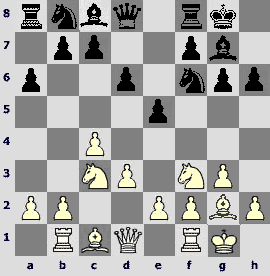
9.b4 ¤h5!? Later I played 9...Ґe6 and equalized confidently: 10.¤d2 c6 11.a4 d5 12.b5 ab 13.ab ¤bd7 14.bc bc 15.cd cd 16.e4 ¤c5 (Simonovich – Bologan, Ulcin 1997).
11.Ґb2 (11.a4 ¤d7 12.¤d2 ¦b8) 11...¤d7 12.Јe2 c6 13.a4 d5. It's customary to consider in such positions that the one who carries out his plan first (White b4-b5 or Black d6-d5), seizes the initiative.
17...d4. This move certainly weakens the h1-a8 diagonal, but White does not have time to make a good use of this weakening because of the e2-queen and the e8-rook confrontation. 17...Јe7?! 18.bc bc 19.cd cd 20.¤b5І.
18.bc (18.¤ce4!?) 18...bc 19.¤ce4 ¤xe4 20.¤xe4 Јe7 21.ed. Knight's invasion on d6 is hardly dangerous: 21.c5 ¦a6 (21...¦a2 22.¤d6 ¦b8 23.eded 24.Ґxc6 ¤xc5) 22.¤d6 ¦ea8.
21...ed 22.¦a1 Ґf5 23.Јc2 h5!
I think that Black's position is more pleasant: his pieces are active, he has more space, while White has a constricted bishop on b2 and the weakness of the d3-pawn can also tell in the long run.
24.¦e1?! The next move of Black should have been prevented by 24.h3!? or even by 24.h4!?
24...h4 25.¦xa8 ¦xa8 26.Ґc1. Exchange of rooks 26.¦a1 ¦xa1+ 27.Ґxa1 h3 28.Ґh1 Јb4 was evidently in Black's favor. In case of 26.gh!? Black does not need to rush regaining a pawn, but can simply strengthen his position by 26...¤c5 (26...Јxh4 27.¤g3).
26...h3 27.Ґh1 Јb4 28.Ґd2 Јa4 29.Јxa4 ¦xa4. About this moment we got into a mutual time scramble. It should be noted that after queens exchange Black's advantage increased: pawn d3 became more vulnerable, and a king on g1 with a pawn on h3 is not in a comfortable position.
30.f4!? (preparing ¤f2) 30...¦a2 31.Ґc1.
The e4-knight is very strong, that's why it should be exchanged:
31...Ґxe4! 32.de?!
32...¤c5 is unpleasant in response to 32.Ґxe4, for example: 33.Ґxc6 (33.f5!? ¤xe4 34.¦xe4 ¦a1 35.¦e1 Ґh6 36.Ґd2 Ґe3+ 37.ўf1 ¦xe1+ 38.ўxe1!? (38.Ґxe1 gfµ) 38...Ґxd2+ (38...Ґg1!?) 39.ўxd2 gf 40.ўe2 ўg7 41.ўf3 ўf6 42.g4 fg+ 43.ўxg4 ўe5 44.ўxh3 ўf4 45.ўg2 ўe3°) 33...¤xd3 34.¦d1 ¤c5! (34...¤xc1 35.¦xc1 d3 36.¦d1 Ґd4+ 37.ўf1! ¦xh2 38.¦xd3=; 34...¦a1 35.¦xd3 ¦xc1+ 36.ўf2 ¦xc4 37.Ґd5 ¦c2+ 38.ўg1 Ґf8µ) 35.Ґf3 f5 with idea ¤e4 and ¦c2.
32...¤c5 33.¦d1. 33.e5 ¤d3 34.¦f1 c5 35.Ґe4 deserved attention.
33...¤b3. Better is 33...¤a4 (with idea ¤c3, d3-d2) 34.Ґf3 ¤c3 35.¦f1 d3 36.Ґe3 Ґf8. But, as I've already mentioned we had been in a strong time trouble.
34.Ґf3 Ґf8. A Zeitnot mistake, 34...¦c2 35.Ґa3 ¦xc4 was winning.
35.f5 ¤xc1 36.¦xc1 Ґh6 37.¦d1 Ґe3+ 38.ўh1 ¦c2??
Misses a win. The correct move here is 38...gf 39.ef c5 40.Ґg4 ўg7 41.Ґxh3 ўf6 42.Ґg2 ўe5 43.Ґf1 (43.¦f1 f6 and d3°; 43.g4 f6 with subsequent ўf4°) 43...ўxf5 44.Ґd3+ ўg4.
39.fg fg 40.Ґg4 ўg7 41.Ґxh3. The easiest way to get a draw was 41.е5!?
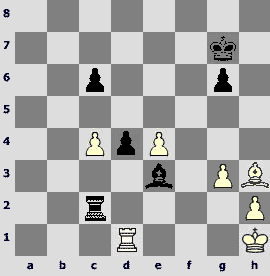
The time trouble was over and the position was objectively equal. At this moment Mark Israilevich Dvoretsky entered the hall. Boris Gulko approached him and they started discussing my position. Dvoretsky said: "Most likely that Viorel will win". "Really? – Gulko was surprised – But the position is drawish!" "Well, Black has the initiative. Besides, we worked a lot on endings with bishops of opposite colors". And the trainer turned out to be right! I think that White's material advantage played a low-down trick on Benjamin (he is a very technical chess player, in general). It's clear that White should not think about win with a patented king on h1, but should aim at fixing a draw.
41...ўf6!? (41...¦xc4 42.e5 ¦c2 43.e6 Ґg5 44.¦f1=) 42.Ґf1 ўe5 43.Ґd3 ¦a2 44.h4?? This mistake cost half a point. Now g3 square weakens hopelessly, and though the way to it can't be seen clearly right away, Black gradually manages to build up a mating structure.
After a simple 44.h3 I did not see how my position could be strengthened, for example: 44...c5 45.Ґb1 ¦b2 46.Ґd3 ўe6 47.Ґb1 g5 48.Ґd3 g4 49.hg ўf6 50.e5+ (50.Ґf1 ўg5 51.Ґh3) 50...ўxe5 51.¦f1 ¦d2 52.¦f5+ ўe6 53.Ґf1=.
44...c5 45.Ґb1 ¦b2 46.Ґd3 ¦f2! Black's plan is already clear but it needs to be prepared. It's too early for 46...g5?! 47.hg Ґxg5 48.ўg1 Ґe3+ 49.ўf1 ¦f2+ 50.ўe1 ¦g2.
47.Ґb1 g5 48.hg Ґxg5 49.Ґd3 Ґe3 50.Ґb1. In case of 50.¦f1 Black can exchange rooks: 50...¦xf1+ 51.Ґxf1 ўxe4 52.ўg2 d3 53.g4 Ґg5 54.ўf2 ўd4 55.ўf3 Ґh6 56.g5 Ґxg5 57.ўg4 ўxc4.
50...ўf6 51.Ґd3 ўg5. The king breaks to g3 and White's situation becomes desperate.
52.¦a1 ўg4 53.¦a7 ¦d2 54.Ґf1 ўxg3 55.¦g7+ ўf4 56.¦d7 ўxe4 57.¦e7+ ўf3 58.¦d7 ¦d1 59.¦f7+ Ґf4 60.ўg1 d3. White resigned.
Lessons:
1) One of the main plans of White in the English opening is a quick advance of the b-pawn to b5 with the purpose of seizing space on the queenside, in combination with light-squared bishop's actions along the h1-a8 diagonal it hampers Black's program advance d6-d5. It is commonly supposed that White gets an advantage in case he plays b5 first and on the contrary Black has a good position if he manages to carry out his plan first.
2) A party which tries tilting the positions with dynamic advantage in its favor, often resorts to a- or h-pawn march. A friend of mine Andrey Shchekachev noticed that Gata Kamsky, for example, had actively used this method already in his early games (23...h5!).
3) It is considered that almost all endings with bishops of opposite colors are drawish. However, in this game the king of White had almost been stalemated on h1, that's why Black had at least a sufficient compensation for the sacrificed material. White was effectively a piece down and he should have tried to find ways of building up a fortress.
"Endgame". This is a title of one of the best (from the point of view of a chessplayer's benefit) chess books that has ever been written. The author is certainly Dvoretsky. With all my respect to his preparation system, he made a real breakthrough in studying, mastering and teaching the final part of the game. In addition to polishing problem solving skills that I have mentioned, the skill of ending analysis was also worked through during his lessons. The punctilious trainer made real discoveries in some endings. I owe many points and half points to our endgame lessons. Also in the next game the radical twist occurred in the end of the game.
The second in my life zonal tournament, as well as the previous one, took place in Nikolaev (Ukraine) in spring of 1995. Only two and a half qualifying spots had been given to the Ukraine, Moldavia, Belarus and Azerbaijan (the third-finished was due to play with a representative of the Baltic zone). It was hardly a fair distribution of invitations among the FIDE zones.
I had to change three planes and two trains to get to Nikolaev in the morning of the first playing day. I came from Linares where I assisted Aleksey Shirov (he played quite successfully). When I got to Frankfurt from Madrid it turned out that the plane to Moscow had already flown away. I fought my way to the plane of American "Delta Airlines" and arrived to Moscow, though later than I planned. I boarded another plane and landed in Kiev, from where I took a train to Nikolaev to arrive on the first playing day.
As a result of this "wonderful" journey I missed a mate on 17th move at hands of Zulfugarli. I was on a verge of defeat by young local chessplayer Vartapetian in the second round as well. In a lost ending, in which I had two pawns against a bishop, I holed my opponent with a simple trick: when I had one and a half minute till the end of the game I suddenly stood up. The opponent, who had a lot of time left, immediately made a move in response, missing a win, and, feeling upset afterwards, even lost the game. I regained my spirit after this, won several games and was finally joined the struggle for qualifying spots.
I played with Romanishin in the middle of the tournament. In our telephone conversation a day before the game, apart from the opening advice, Mark Izrailevich had mentioned that my opponent is fond of sacrificing a pawn for the initiative.
Bologan – Romanishin
Nikolaev 1995
Three Knights Defense
1.e4 e5 2.¤f3 ¤c6 3.¤c3. I decided to surprise the Lvov grandmaster with a variation, which was new for me but did not remain in my repertoire for a long time. When playing against a particular opponent, it's often possible to get into less principled schemes – I knew that my opponent usually brings a bishop on c5 in response to 3.¤c3.
3...Ґc5. It's not the most principled move.
4.¤xe5 ¤xe5 5.d4 Ґd6 6.de Ґxe5 7.Јd3!?
A classical opposition of e4- and d7-pawns arose after the exchange on e5. White has a certain advantage – he has more space and the control over the d-file hampers a liberating d7-d5 break. Exchange of a pair of pieces and active position of the e5-bishop can be considered as Black's achievement, for this reason it's much easier for him to complete the development than in most cases.
7.f4 Ґxc3+ 8.bc d6 9.Ґd3 is also interesting, and White gets the advantage of two bishops and good prospects.
7...¤f6 8.Ґd2 0-0 9.0-0-0 ¦e8. Original position arose, that looked like Philidor Defense, Scotch Opening and Central Opening at the same time, in which there is much room for creative ideas. It pleased both players.
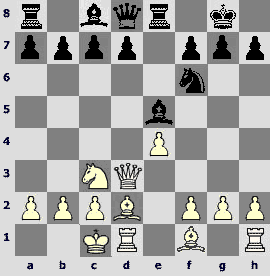
10.f3!?
10.¦e1 c6 11.h3 (11.g3 d5 12.ed Ґxc3 13.Ґxc3 ¤xd5 14.¦xe8+ Јxe8 15.Ґd2 Ґe6 16.Јd4 Јd7 17.c4 ¤b6 18.Јxd7 ¤xd7 19.Ґc3= Korneev – Romanishin, Saragosa 1996; 11.f4 Ґxc3 12.Ґxc3 d5=) 11...h5 12.f4 Ґxc3 13.Ґxc3 d5 14.ed ¤xd5 15.¦xe8+ Јxe8 16.Ґd2 a5 17.Јe2 Ґe6= (Larsen – Torre, Bad Homburg 1998).
10...c6 11.g4 d5! Black becomes first to sharpen the position: he carries out a planned break in the center, after that all his pieces enter the play. He has to give away the bishop, but this is not very dangerous. Worse is 11...Јb6? 12.Ґe3 Јa5 13.Ґd4±.
12.ed (12.g5?! ¤h5 13.ed ¤f4 14.Ґxf4 Ґxf4+ 15.ўb1 Јxg5›) 12...Ґxc3 (12...¤xd5? 13.¤xd5 Јxd5 14.Јxd5 cd 15.f4 Ґc7 16.h3 Ґd7 17.Ґg2 Ґc6 18.¦de1±) 13.Ґxc3 ¤xd5 14.Јd4 Јg5+ 15.Ґd2 Јf6 16.Јxf6 ¤xf6.
This ending is certainly in White's favor thanks to his two bishops. But my next move turned out to be not very good.
17.h4?! Better is 17.h3 Ґe6 18.¦h2 Ґd5 19.¦f2 ¤d7 20.¦e1. 17.Ґd3 Ґe6 18.¦he1 Ґd5 19.¦xe8+ ¦xe8 20.¦f1 leads only to equality.
17...h5!= (17...Ґe6 18.h5 Ґd5 19.¦h3І) 18.g5 ¤d7?! Correct is 18...¤d5, to strengthen the light squares after 19.Ґd3 Ґe6 20.¦de1 ¤e7 (planning ¤f5) 21.¦e5 ¤g6 with equality. By the text move Black protects the c8-bishop, and one makes use of it.

19.g6!! Like cures like! I used the favorite method of the opponent and offered my pawn for the initiative. Those who like attacking often do not like defending. 19.Ґc3 ¤f8 20.Ґd3 ¤g6=.
19...fg (19...¤f6 20.gf+ ўxf7 21.Ґd3 Ґe6 22.¦hg1±; 19...¤e5!? 20.gf+ ўxf7 21.Ґc3 Ґf5 22.Ґe2) 20.Ґc4+ ўh7 21.¦he1 ¤f6 22.Ґf7! White starts fighting for e7. Weaker is 22.¦xe8 ¤xe8 23.¦e1 ¤d6 24.Ґb3 Ґf5 25.¦e7 ¦e8 26.¦c7 ¦c8=.
22...¦xe1 23.¦xe1 Ґh3! 24.¦e7 b6 25.c4. Depriving the knight of the d5-square. It's clear that White has advantage as the black pieces are very constrained and an extra pawn is not very significant.
25...Ґg2 26.Ґc3 ўh6 (26...¤g8? 27.Ґxg6+ ўxg6 28.¦xg7+ ўf5 29.¦xg2ќ) 27.f4 a6 28.a4. It's very important to understand how the queenside pawns should be placed correctly.
28...b5. Oleg Mikhailovich decided to take the strain off, but after 29.a5! White fixes retarded pawn on a6.
29...¦d8 30.Ґe6 (30.ўc2 Ґf3 31.ўb3І) 30...Ґf3.
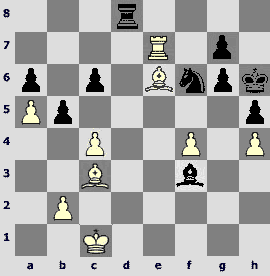
31.c5! A paradoxical decision: it was important to realize that the exchange of light-squared bishops will turn out to be in White's favor.
31...Ґg4 32.Ґb3. One certainly should not exchange on g4 as in this case Black gets a dangerous passer. Also bad is 32.Ґe5 ¦e8 33.Ґxf6 ¦xe7 34.Ґg5+ ўh7 35.Ґxe7= (35.Ґxg4?? hg 36.Ґxe7 g3°).
32...¦d7 33.¦e1 Ґf5 34.Ґc2! The point is that in case of the exchange of bishops White captures a very important e6-square.
34...Ґg4. Black declines the trade as both 34...ўh7 35.Ґxf5 gf 36.Ґxf6 gf 37.¦e6 ¦d4 38.¦xc6 ¦xf4 39.¦xa6 ўg6 40.c6 ¦xh4 41.¦b6 ¦c4+ 42.ўd2 h4 43.a6 h3 44.a7 and 34...Ґxc2 35.ўxc2 ¤d5 36.¦e6 ¤e7 (36...¤xf4 37.¦xc6) 37.¦d6 (37.Ґe5 ўh7›) 37...¦a7 38.Ґe5 ўh7 39.ўd3 ўg8 40.ўe4 ўf7 41.¦d8 ¤f5 42.¦c8 ¤xh4 43.¦xc6 ¤f5 44.ўf3 are bad for him. Black certainly can defend more precisely, but whatever the case, White has a strong initiative, which is especially unpleasant in the time trouble, even when it's mutual.
35.Ґe5 ўh7 36.Ґd6 Ґf5. He has to agree to trade since otherwise there is no way for the king to get away from h7.
37.Ґxf5 gf 38.¦e6 ¤e4 39.b4! (39.Ґe5? ¤xc5 40.¦xc6 ¤b3+ 41.ўc2 ¤xa5 42.¦xa6 ¤c4) 39...¤f6. Black has a lost position after 39...¤xd6 40.¦xd6 ¦c7 41.ўd2 ўg8 42.ўd3 ўf7 43.ўd4, however 39...ўg8!? 40.Ґe5 ¤f2 41.ўc2 ¤d3 42.Ґc3 (42.ўc3 ¤xe5 43.¦xe5 ўf7І) 42...¤xf4 43.¦xc6± deserved attention.
40.ўc2 ўg8 41.Ґe5 ¤d5 42.ўb3 ¤e7 43.¦d6 ¦a7 44.ўc3.
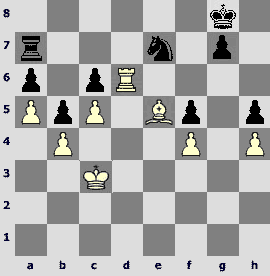
I assess this position as won for White. My plan is very simple: ўd4, ¦d8, Ґd6, ўe5.
44...ўf7. In response to 44...¤d5+ 45.¦xd5! decides: 45...cd 46.ўd4 ўf7 47.ўxd5 ¦d7+ 48.Ґd6 ўe8 49.c6 ¦f7 50.ўc5.
45.ўd4 ¦b7 (45...ўe8 46.Ґxg7 ¦d7 47.ўe5) 46.¦d8 ¦a7 47.Ґd6. White has a classical advantage: a rook and a bishop are stronger than a rook and a knight; besides, his king is active. Black's pieces are gradually pushed aside to the edge of the board.
47...¤d5 (47...¤g6!? 48.¦c8 ¤xh4 49.¦xc6 ¤g6 50.ўe3 h4 51.ўf3ќ) 48.ўe5 ўg6 (48...¤xb4 49.ўxf5 g6+ 50.ўg5) 49.Ґb8 ¦a8 50.ўd6 ¤xf4 (50...¤xb4 51.ўc7 ¤d5+ 52.ўb7ќ) 51.ўxc6 ¤e6 52.¦d6 ¦xb8 53.¦xe6+ ўf7 54.¦e1 g5 55.hg ўg6 56.ўd7 f4 57.c6 ўxg5 58.c7 ¦b7 59.ўc6 ¦xc7+ 60.ўxc7 f3 61.ўb6. Black resigned in view of 61...ўf4 62.ўxa6 f2 63.¦f1 ўg3 64.ўxb5 h4 65.a6 h3 66.a7.
Lessons:
1) It's advisable to engage opponent's pawns on the squares of "extra" bishop in case your opponent has a two bishop advantage. By forcing the g4-g5 advance (17...h5), Black plans to set control over the weakened light squares using his bishop and knight.
2) A pawn sacrifice is uncommon for the endgame, but this tool can be useful as well. This is quite a natural continuation especially when one has two bishops and his opponent lags in development. There is nothing to be afraid of for White: at least he will have a compensation for a pawn (19.g6!), as so many files get opened. In this case the sacrifice was forced in a way because Black threatened with a possibility of settling comfortably on f5.
3) It is very important to use nonstandard way of thinking in chess. Sometimes when you choose the move, general tactical considerations are more important than some particular reasons (for example, weakening of certain squares, etc.). The move 31.с5 seems to be a positional blunder, as d5 is given away to the opponent. However, a general rule is known: the lesser pawns are on board the easier it is to defend. Thus, by 31.с5! White in fact fixes a pawn structure of Black at the queen side and in case he manages to burst there, he will capture three pawns.
***
Meanwhile I was working on my thesis. For successful defending, regardless of the research field, one had to obtain and process certain experimental data. Taking into consideration that the subject of my thesis was - training of high-skilled chessplayers, I decided to work out a detailed questionnaire, which suggested every IM or GM I had been keeping under observation to assess their state during tournaments. Though this was a clearly subjective assessment, I did not see other way of getting quite interesting data. The main characteristics of a chessplayer's readiness for competitions were special (chess), functional and psychological ones. Certainly, the thesis contained not only my data, but also data of 19 more chessplayers. Consequently, many interesting rules had been discovered.
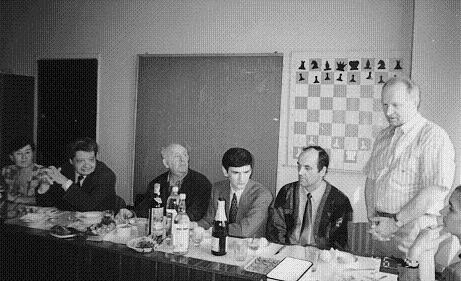
Defending the thesis
The funniest thing is that the sixth tournament in a row, the Novgorod open, turned out to be the most successful for me. Against a background of great physical fatigue, a chess component was at a high level, and I managed to win the open which was considered to be a qualification for the Novgorod supertournament. However, I was not admitted to the next year's supertournament under a dubious pretext. It was said that one should have had 2600 Elo rating, but I had that coefficient...
It's clearly seen from my plot that my results curve has a strong correlation with psychological state curve. I went To Novgorod with Viorel Iordachescu. At that time I helped him a bit in his development as a chessplayer. There was a nice atmosphere in our relationship and both of us played successfully. In addition I liked the city very much, and it is still the most attractive of all Russian cities for me, even with Moscow and St. Petersburg taken into account. I enjoyed the spirit of old days, regularity of life, Volkhov river with its gently sloping coasts as if emerging from fairy tales, abundance of churches and monasteries... I remember a trip to Staraya Russa in the year when I was seconding Alexei Shirov, a visit to the last abode of Dostoyevsky. Unfortunately I haven't been there since 1995, but I will certainly come again!
The tournament itself was very tense for me as I lost my "obligatory" game, - it usually happens that I need to be defeated to show my determination and win the tournament. That time a defeat by Peter Svidler in the fourth round was a kind of accelerator (we both started with three wins). Everybody including Kasparov, who played in the main tournament, considered that Peter will be the winner of the open. Garry Kimovich sympathized with him. He has this habit of sympathizing with someone. After that Svidler defeated him in Tilburg. Kasparov also sympathized with Kramnik... So, this habit of sympathizing with young talented players is not very advantageous for Kasparov! As I was told, Kasparov did not look very pleased when he found out that it was Bologan who won the open.
* * *
Viktor Borisovich Malkin, M.D. was my academic adviser during the postgraduate studies. I saw him first at the chess board in the head of chess department office . He radiated unfeigned passion and keenness on the struggle process. Though he was just a chess Don Quixote in a purely sportive sense, he succeeded in introducing scientific component into chess. How does a person think, which aspects influence his decision-making, which specific character does chess thinking have? Viktor Borisovich tried answering these and many other questions with the help of modern technical equipment. EEGs of the famous chessplayers during the play are still awaiting to be published.
He was a real scientist – a bit abstracted, a bit strict, very frank, and, at the same time, hospitable and friendly. He was a very pleasant person. Till the last days of his life he had a quick mind, one could always learn something from him. When working on the thesis, he preferred not to pay much attention to the technical details and particular mistakes. He was rather interested in the heart of the problem. It was he who introduced such a comprehensive definition as a "playing status of a chessplayer". This definition includes purely chess knowledge as well as physical form and psychological state of a chessplayer. Malkin was just sitting and thinking aloud. His reasoning helped me bringing the thesis to the level when it was successfully defended on May, 7th, a birthday of my scientific adviser.
In spite of generally systematizing character of my work, it was not easy to do it. I had to rewrite the thesis five times trying to find ways of presenting my research work in a scientific form. While in other kinds of sport there was a beaten path to the candidate of sciences degree, in chess it was necessary to determine the whole set of chess concepts, such as tactical sight, consideration of the opponent's resources, opening preparation etc. Data processing was much easier as the processing principle was inhered in the basis of the thesis.
It's interesting now, nine years later, to compare myself with a self portrait I got in 1996:
Viorel Bologan's characteristic
1. Individually significant special skills: sense of danger, "insight" (i.e. the ability of offering the most unexpected hypothesis quickly, ability to check, change, modify it quickly or suggest another one if needed – V.B), ending theory, use of technical means for preparation, day regimen, nutrition, determination, self-regulation, emotional state, stress resistance, consideration of the opponent's psychology.
Memory and physical training were among steadily low characteristics.
2. Bologan's result has a strong reliance on the level of psychological preparedness. It's important to note that even in the successful tournaments he had a low functional preparedness. Bologan should improve his preparation in this aspect. His unsuccessful performances in many respects can be explained by a poor scheduling of day regimen during the competitions.
It's necessary to add that my scientific research had quite unexpected, but pleasant side effect. Almost the day before I was to defend the thesis, in the end of April 1996, I managed to win a qualification for the Moscow stage of the PCA Grand Prix in rapid chess, ahead of more than 60 grandmasters, and to get on the stage of the Kremlin Congress Palace to the company of chess celestials. I did not look at chess for two months before the tournament.
It was the first big sum of money I earned. The happiness was boundless. Due to the system of fair sporting qualification, the chessplayers who were not among the elite got their chance to prove the competence. Unfortunately, the likes of us do not understand where money comes from. In a word, sponsors did not continue the good for chess undertaking in view of its unprofitability.
My post graduate studies automatically came to an end after I had defended the thesis, and again I was at the crossroads. Shall I stay in Moscow or come back to Moldavia? This eternal question has been following me all my life until now, and no definite answer can be seen. I've always been light on my feet, so I abandoned Strogino (it seemed forever those days) and arrived to native Kishinev seven years after I left it. I immediately started settling in. I went to play in a tournament in Vienna.
Bologan – Tischbierek
Vienna (Austria) 1996
Alekhine's defense
This game was played in the tournament that was dedicated to the 1000th anniversary of Vienna. There was a very strong line-up in the open: I remember an episode that happened in the main tournament when two irreconcilable enemies, Karpov and Korchnoi, having drawn their game, were nicely analyzing it for a few hours. I did not play very successively, however in the last round I managed to implement an interesting idea of Vjacheslav Andreevich Chebanenko in the Alekhine's defense.
1.e4 ¤f6 2.e5 ¤d5 3.d4 d6 4.¤f3 Ґg4 5.Ґe2 e6 6.h3 Ґh5 7.c4 ¤b6.
One of the main variations of the Alekhine defense had been played. Wasting time on knight moves, Black accepts a particular underdevelopment and gives the center to the opponent. However, the f6–knight appears on quite a flexible position after moving on b6: is it attacks the c4-pawn and supplements the c6-knight rather well – black knights set up an unpleasant pressure on the center. The c8-bishop has time to get on g4, so Black obtains a good cooperation between pawns and other pieces. The trump cards of White are his central and spatial advantage – he just needs to solve the problem of the c4-pawn.
8.ed cd 9.¤c3 Ґe7 10.d5!? (10.0-0 0-0 11.Ґe3 d5).

A conceptual novelty of Chebanenko. White prevents d6-d5 with subsequent pressure on the d4-pawn.
10...e5?! This natural retort is a positional mistake. It seems that after 10...0-0 11.de fe 12.¤d4 Ґf7 13.0-0 ¤c6 14.Ґe3 ўh8 15.b3 d5, as it was in the game Gongora – Nogueiras, Olgin 2002, Black is ok.
11.Ґe3. Such pawn structure can arise in different variations of the Sicilian defense. White hasn't castled short, that's why the h5-bishop is vulnerable to g2-g4 and h3-h4.
11...Ґxf3!? This is still Chebanenko's analysis. Now Black is constrained on both queenside and kingside. 11...¤8d7 12.g4 Ґg6 13.h4 h5 (13...h6 14.Ґd3 (14.b3 a6 15.Ґd3 Ґxd3 16.Јxd3 ¤c8 17.ўe2 ¤f8 18.¤e4І Zapata – Baburin, Bled 2002) 14...Ґxd3 15.Јxd3 ¤f6 16.¦g1±)14.g5 ¦c8 15.b3 ¤c5 (15...Ґf5 16.¤d2 g6 17.¤de4±) 16.¦g1 ¤bd7 17.b4 e4 18.¤d2 ¤d3 19.ўf1 ¤xb4 20.¤dxe4 0-0 21.Ґd4 ¦e8 (Hamdouchi – Baburin, Saint Vincent 2000).
12.Ґxf3 ¤8d7. It's clear that the c4-pawn can not be captured because of the check on a4.
13.Јe2 ¦c8 14.b3 f5. German grandmaster Raj Tischbierek (now he is the editor of Schach magazine) decides to sharpen the play. In case of 14...0-0 I was going to play 15.g4 Ґg5 16.h4! Ґxe3 (16...Ґxh4 17.Ґe4 g6 18.Јf3‚) 17.Јxe3, and the outpost e4together with a possibility of attacking the king, gives White an advantage.
15.g4! The move is absolutely reasonable: White has two bishops and advantage in the center, besides, black king has not castled yet.
15...e4. Otherwise Black's position is simply bad, for example:15...g6? 16.gf gf 17.Ґh5+ ўf8 18.Ґh6+ ўg8 19.¦g1+; 15...f4 16.Ґd2 ¤c5 17.¤e4 ¤bd7 18.¤xc5 ¤xc5 19.b4 ¤d7 20.¦c1 0-0 21.ўf1. Now the main point is whether Black manages to hold the e4-pawn.
16.Ґg2 Ґf6.
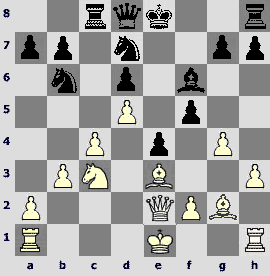
17.¤b5!! Positional rook sacrifice is not very difficult, but quite spectacular. 17.¦c1 Ґxc3+ (17...¤e5 18.0-0 ¤d3 19.¦c2 ¤b4 20.¦cc1 (20.gf ¤xc2 21.Јxc2 Ґxc3 22.Јxc3 0-0) 20...¤d3=) 18.¦xc3 ¤xd5 19.¦c1 ¤xe3 20.Јxe3 Јa5µ.
17...Ґxa1 (17...¤c5 18.Ґxc5 ¦xc5 19.¦d1 a6 20.¤d4 Ґxd4 21.¦xd4 Јf6 22.Јe3 0-0 23.gf Јxf5 24.0-0±) 18.¤xd6+ ўf8. 18...ўe7 loses to 19.¤xf5+ ўf8 20.0-0, for example: 20...Ґf6 21.g5 Ґxg5 22.¤d4 ¤c5 23.b4 ¤bd7 24.bc ¤xc5 25.f3 Ґxe3+ 26.Јxe3 ўg8 27.feg6 28.e5 ўg7 29.e6 ¦f8 30.Јe5+ ўg8 31.¦xf8+ Јxf8 32.e7 Јf7 33.d6.
19.0-0. Castling on the move 19 in an incredibly sharp position! So that students won't tell afterwards: "You teach us developing pieces, but you do not castle yourself!" Indeed, White has only a rook, and Black has two rooks. However, after the f2-f3 break my rook will play, while it's difficult to tell after which moves the rooks of Black will start playing. Certainly, the d6-knight should not be given for the c8-rook.
19...Ґe5. In case of 19...Ґf6 the following course of event is possible: 20.g5! Ґxg5 (20...Ґe5 21.¤xf5 g6 22.f4! ef (22...gf 23.fe ¤xe5 24.¦xf5+ ¤f7 25.Јh5 ¦c7 26.g6ќ) 23.Јxf3 gf 24.Јxf5 Ґf6 25.gfќ) 21.Јh5 g6 22.Јxg5 Јxg5 23.Ґxg5 ¦b8 24.f3 ef 25.Ґxf3 ¤c8 (25...¤e5 26.Ґf6 ¤xf3+ 27.¦xf3 ¦g8 28.¦e3 ¤d7 29.Ґd4ќ) 26.¤b5 ўf7 27.Ґf4 ¦e8 28.Ґxb8 ¤xb8 29.c5±.
20.¤xf5! (20.¤xc8 ¤xc8 21.gfі) 20...h5? The best chance for Black was 20...g6, after which White should attack very precisely: 21.¤d4 Ґxd4 (21...Јf6 22.¤e6+ (22.f3!?) 22...ўg8 23.f3 ef 24.¦xf3‚) 22.Ґxd4 ўf7 (22...¦g8 23.f4 ¦g7 24.Јxe4 Јe7 (24...¦e7!?) 25.Ґxg7+ Јxg7 26.f5ќ) 23.f4 ¦e8 24.f5 g5 25.f6 ¤f8 26.Јe3 h6 27.h4 ¤h7 ( White wins beautifully after 27...Јd7 28.¦f5 ¤h7 29.Ґxe4 ¤xc4 30.bc ¦xc4 31.hg ¤xg5 32.¦xg5! hg 33.Ґg6+! ўxg6 34.Јd3+) 28.Ґxe4ќ.
Bad is 20...ўg8 21.f4 ef 22.Јxf3 h6 23.d6 Ґf6 24.¤e7+ ўf8 25.Јxb7 ¦b8 26.Јe4ќ.
21.f4. All white pieces take part in the attack. They are not as numerous as Black's, but it is sufficient for mating.
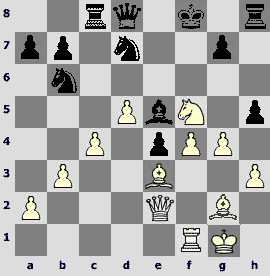
21...ef (21...Ґf6 22.g5 g6 23.¤h4ќ) 22.Јxf3 ўg8 (22...Јf6 23.g5 Јf7 24.Јe4‚) 23.d6. The outline of the mating net starts appearing.
23...¤f6 (23...Ґf6 24.g5 Ґxg5 25.¤e7+ with a win) 24.g5. And Raj resigned in view of 24...¤bd7 25.¤e7+ ўf7 (25...ўf8 26.¤g6+) 26.Јd5+.
Lessons:
1) A mistake in the opening can affect all subsequent play. One should very carefully define a pawn structure. Black made a mistake (10...е5) as White could sharply improve his position on the queenside and even with tempi.
2) When Black gets a pair of pawns e5-f5, it often makes sense to struggle for the squares, which are controlled by these pawns. For this purpose White undertakes f4 or g4 to make the attacked pawn move forward, abandoning the control of d4 or e4 (15.g4).
3) Some sacrifices can be assessed without calculating many variations. White gets at least two pawns for the sacrificed rook, in addition all his pieces will be attacking. While Black has to loose a few tempi in order to return the bishop from a1, black king does not have a pawn shelter and the pieces are disconnected. For this reason the rook can be sacrificed without any hesitation (17.¤b5!).
When I came back to Kishinev, I felt as if I was a plant that can not strike root on a new place. In a word I endured two months. I had almost suffocated with a narrow-minded provinciality. I've always loved and I still love Kishinev, but I think that after the breakup of the USSR the city and its citizens have lost much. I was out of it. And in support of the fact that my decision to return to Moscow was right, immediately after my return there was another breakthrough to the assembly of the great, this time it was the Geneva stage of the Grand Prix in September. Having qualified by a miracle, I managed to defeat Chernin and get to the quarter final. However, I turned out to be helpless against Anand, who eventually became the winner.
I will not accuse of anything Vishwanatan, whom I respect very much, I just want to share my quite interesting impressions I had during the match against him. In the first game after a small tactical skirmish in a complex ending we transferred into a drawish one with opposite-colored bishops. Vishy, who did not see anything better, put the rook under exchange and looked at me as if offering a draw. I declined a draw and already five moves later I could resign. I had White in the next game and even managed to get the advantage. But, I was sitting as if hypnotic for about 20 minutes (there were just 25 minutes for the whole game) and could not make myself move a piece. By the way, I fell into the same stupor when I played against Anand in New Delhi in 2002. That time in view of the threat of losing on time I just made myself offer a draw in a better position.
...At first I lived in the flat of my university friend Misha Pleshkov and only at the turn of the year I returned to Strogino, to the same flat, and to the same rhythm of life.
